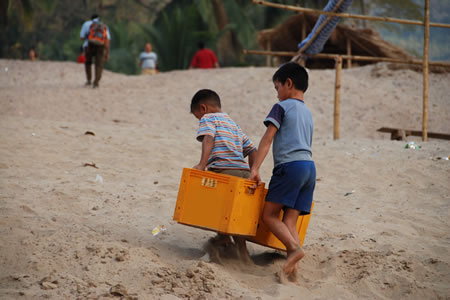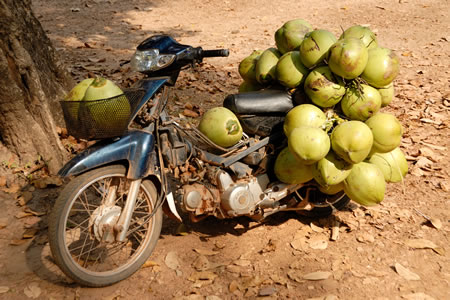English | Dutch |
|
| Means of transport in Cambodia | |
Stung Treng (Cambodia), February 9th 2009 |
|
This article is written by Jan, the father of Ivonne During our trip through Cambodia, we have seen a lot of “means of transport” in action. What follows is a short, incomplete summery of those things that are used to transport men, animals and goods. First and foremost, there are the legs. Most people in Cambodia are blessed with two of these members and 90% of those people are wearing flip-flops at their feet. Children who lack this kind of footwear are finding their way on bare feet. Rock, gravel or thorns, neither can stop them. As result of land mines (that keep on making casualties until this moment and beyond!), some Cambodians have to cope without legs. They rely on a kind of old fashioned invalid chair that you would not see in use in Europe anymore. However, it serves them well and this chair gives them the opportunity to stay connected with the world outside of their homes. Also the human head transports all kinds of things, like baskets filled with fruit, boxes and laundry. While carrying these loads, the women move with such grace that I couldn’t copy. On back and shoulders are heavy weights transported by young and old. When seeing those children under these loads, I can’t stop thinking about the political slogan that is used very often in the Netherlands: “The strongest shoulders should accept the heaviest loads”. In Cambodia, weak shoulders aren’t exempted from heavy loads. All shoulders (strong or weak) carry loads that no working man in the Netherlands has to carry because of the overregulation about how tough a job can be. Often, I see children carrying loads that make their legs almost break down. Their parents are at the same time invisible under the large piles of branches. |
|
 |
|
Children are not spared for the heavy work |
|
Another important mean of transport is the bicycle. It is funny to see how some children ride a bike that seems far too big for them. Some are sitting on the saddle and push the one paddle down in the hope to get the other paddle up. Others are standing on the paddles while they have to keep their body underneath the bicycle rod. Their legs are simply too short to stay with their bottoms above the rod when they need to put their feet on the paddles. The motorcycle is probably one of the most multi-functional machines to transport all kinds of things. One evening, we amused ourselves by simply looking at the hundreds of motorcycles that cruised quietly through the streets. Most of the times, four of five people are on one motorcycle at once. Father is steering while one of the children is sitting on the fuel tank. Behind his back are two other children, while mother is sitting at the back. We have also seen a mother that was steering the motorcycle with one hand, while holding her child in the other hand and still she was still finding time to smoke a cigarette. Probably the most remarkable sight was seeing a family on a motorcycle where one of the children had an infusion. We have seen it several times that the mother was holding the child and the bag with the infusion fluid while the father manoeuvres through the traffic. While these are examples of the motorcycle that is used to transport people, it isn’t surprising that these all-purpose vehicles are also used to transport all kind of other things. Pigs are tied up alive on the back of the motorcycle, while chickens are hanging up-side-down on the steer. Even 4 metre long planks are transported on a motorcycle by tying them underneath the steer and fixing them at the back of the motorcycle. One time, Edwin and I had to help a driver of a motorcycle that was overloaded with coconuts. He couldn’t put the motorcycle upright on his own, after it had fallen because of the heavy weight. We will also never forget the motorcycle that transported a king-size bed that towered above the driver. Next to taxis and rickshaws, I should also not forget to mention the tuc-tuc. This mean of transport will carry you very comfortable to your destination, if you are blessed with strong nerves. For us, people who are used to traffic where the rule of law is mostly obeyed, it is difficult to figure out who has right of way. Moreover, there are constantly bicycles, rickshaws and tuc-tucs coming towards us on a one-way street. On crossroads, it is always the question whether there is someone willing to stop for you. The best advice is to assume that nobody will give way to you and if you are confident enough to cross the road: do so without hesitation. | |
 |
|
A heavy loaded motorcycle with coconuts at the Angkor temples |
|
| In the rural areas of Cambodia, horse and cart are also often used to transport vegetables, branches and hay. Many times, the carts are heavily overloaded which made it difficult to see whether there was a horse, water buffalo or ox in front of the cart. Near the market places, the hand cart is regularly used. These carts are often loaded with vegetables, smelly fish, meat or fruit.
The bus is the most important mean of transport when people (or goods) have to travel long distances. It is an unusual experience to make a bus ride in the midst of the local people. The bus only leaves when it is full, and this means really full. Also the aisle has to be as full as possible. On top of the bus are piles of goods, so every spot on the bus is completely utilized. At the beginning of the trip, small plastic bags are distributed among the passengers. I, completely inexperienced with travelling by public transport, didn’t know the use of those bags. Within the first fourteen kilometres, I started to get a clue after a penetrating smell reached my nose. At several places in the bus, these bags were filled (sick bags) because of the bumpy road. The filled bags were in some cases thrown out of the windows, while others kept it lying next to their lunch. The way that the children behave is also remarkable. Children are staying quiet during long bus rides. For them, there are no DVD’s of comic books. They just sit and wait until they are at their destination. The babies, who are still breastfed, have a good day when they are travelling on a bus. Every time that they are getting a little bit annoying, they get food. The mothers don’t want to be put up with a crying child. Probably to make sure that all those means of transport can make use of the roads, there is also police “present”. I still don’t understand what the purpose is of those people. Once in a while, I get the feeling that their task includes “keeping your nose out of traffic regulations”. Most of the time, these men don’t do a thing. In Phnom Phen, we have seen a few of the men in action but nobody took this seriously. At least a third of the tuc-tucs and the motorcycles that got a stop sign of this officer, passed him by closely. The officer wasn’t bothered, as he was a typical Cambodian. Cambodians: beautiful people who I will always remember. | |